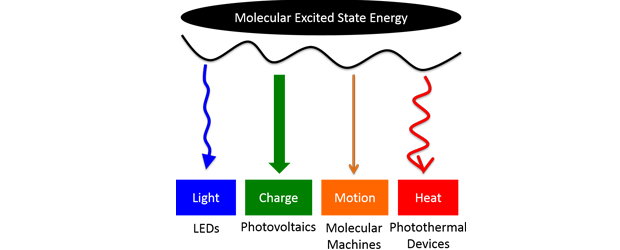
The ultimate goal of this research is to obtain the ability of designing and constructing artificial multifunctional photoactive molecular systems that can efficiently convert excitation energy to any desired forms of energy on demand, including light emission, electricity, molecular motion, and thermal energy. Currently researchers have achieved great success in developing molecular systems for a single type of task. For instance, organic light emitting diodes using heavy metal complexes as emitter can realize 100% internal quantum efficiency, so do organic solar cells based on molecular light harvester. However, synthetic photoactive molecular systems prepared to date are generally less sophisticated structurally and functionally than natural systems, due to inadequate synthetic methodology and lack of guidelines for the design of complicated molecular systems. Furthermore, multifunctional photoactive molecular systems with tunable and environmentally responsive excited state dynamics are rarely available. Thus it is of great significance to develop versatile molecular architectures that allows a systematic study of excited state dynamic processes and excited state energy flow.
Our research involves (i) synthesis and characterization of new multicomponent molecular systems, (ii) detailed studies of the excited state dynamics by using spectroscopy tools and theoretical calculations, and (iii) exploration of potential application of these new molecules. Overall, by combining experimental and computational efforts, we aim to achieve synthetic control of the potential energy surfaces of photoactive molecular systems, as well as their excited state energy decay pathways, including radiative decay, energy transfer, charge separation, or structural change.
